Fribourg
Fribourg (French Fribourg [fʀibuːʀ], Italian Friburgo, Friborgo, Swiss German Frybùrg [ˈfribʊrg], in regional Sensler German [ˈfriːbʊrg] or [ˈfriːbərg], Franco-Provençal ![]() ) is the capital of the canton of the same name and of the Saane district. To distinguish it from the German Freiburg im Breisgau, the addition im Üechtland (short i. Ü. or i. Üe.; pronounced [ˈyəçtland]) or (Switzerland) may be used. Fribourg, with a population currently approaching 40,000, is the fourth largest city in French-speaking Switzerland after Neuchâtel.
) is the capital of the canton of the same name and of the Saane district. To distinguish it from the German Freiburg im Breisgau, the addition im Üechtland (short i. Ü. or i. Üe.; pronounced [ˈyəçtland]) or (Switzerland) may be used. Fribourg, with a population currently approaching 40,000, is the fourth largest city in French-speaking Switzerland after Neuchâtel.
Fribourg, situated on both sides of the Saane in the Swiss Mittelland, is an important economic, administrative and educational centre with a bilingual university on the cultural border between German- and French-speaking Switzerland. The well-preserved old town lies on a narrow rocky spur above the valley of the Saane and its narrow alluvial plain.
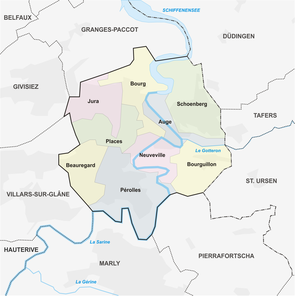
Fribourg quarters
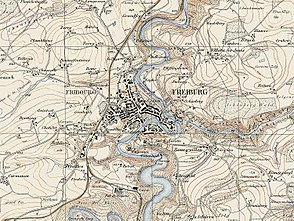
Freiburg and surroundings in the Siegfried Atlas (1874)
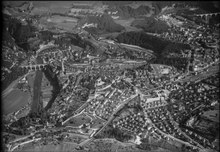
Aerial photograph by Werner Friedli from 1949
Geography
The old town of Fribourg lies at 581 m above sea level. 28 km southwest of Bern (as the crow flies). The city extends on the plateau on both sides of the Saane (French Sarine), whose river bed is cut deep into the Molasse sandstone layers here, in the Swiss Mittelland. The old town is situated on a meandering spur just over 100 metres wide to the west of the Saane, around 40 metres above the river valley floor. Most of the town quarters are on the high plateau at an average altitude of 620 metres and on the adjacent hills, while the Saane valley floor is inhabited only just in the area of the old town meander, the formerly poor lower town. The lowest point of the town is at 525 m above sea level in the Windig area.
The area of the municipality, which at 9.3 square kilometres is relatively limited for a town, comprises a section of the molasse plateau in the Fribourg Mittelland. From south to north, the area is crossed by the strongly meandering course of the Saane, which has cut up to 100 metres deep into the plateau as a result of erosion. The valley floor is generally 200 to a maximum of 500 metres wide. South of the town is Lake Pérolles, dammed in 1872, with the oldest gravity dam in Europe. Around one kilometre north of the old town, the damming of Lake Schiffenen already begins. At each of the reservoirs, the Saane takes up almost the entire available width of the valley floor.
On both sides, the flat valley floor is flanked by largely wooded steep slopes, some of which are interspersed with sandstone fluvias. This is followed to the west by the high plateau of Fribourg (610 to 630 m), which in turn is bordered by the molasse hills of Chamblioux (681 m) and Le Guintzet (690 m). To the east of the Saane, the municipal territory extends to the heights of Schönberg (French: Schœnberg), which at 702 m above sea level is the highest point in the municipal area, and Bürglen (French: Bourguillon; up to 700 m). Between them is the Galtera (French: Gottéron) ditch, which also dips into the plateau and flows into the Saane in the area of the old town meander. In 1997, 61% of the commune's surface area was occupied by settlements, 18% by woodland and copses, 14% by agriculture and slightly less than 7% was unproductive land.
The political municipality of Fribourg includes the former hamlet of Bürglen (655 m) on the plateau south of the Galterngraben as well as part of the Schönberg quarter (up to 700 m) on the eastern city boundary north of the Galterngraben; the larger part is already on the municipal territory of Tafers. Fribourg's neighbouring municipalities are Düdingen and Tafers to the east, St. Ursen and Pierrafortscha to the southeast, Marly to the south, Villars-sur-Glâne and Givisiez to the west and Granges-Paccot to the north.
Urban quarters
| German quarter | French | BFS code | InhabitantsEnd |
| Castle | Bourg | 2196011 | 2'400 |
| Beauregard | 2196012 | 7'527 | |
| Jura | Jura | 2196013 | 6'220 |
| Pérolles | 2196014 | 6'023 | |
| New Town | Neuveville | 2196015 | 1'553 |
| Au | Eye | 2196016 | 1'088 |
| Schönberg | Schoenberg | 2196017 | 9'485 |
| Places | 2196018 | 3'144 | |
| Bürglen | Bourguillon | 2196019 | 691 |
Climate
| Freiburg | ||||||||||||||||||||||||||||||||||||||||||||||||
| Climate diagram | ||||||||||||||||||||||||||||||||||||||||||||||||
| ||||||||||||||||||||||||||||||||||||||||||||||||
| Monthly average temperatures and precipitation for Freiburg
Source : www.meteoschweiz.admin.ch | |||||||||||||||||||||||||||||||||||||||||||||||||||||||||||||||||||||||||||||||||||||||||||||||||||||||||||||||||||||||||||||||||||||||||||||||||||||||||||||||||||||||||||||||||||||||||||||||||||||||||||||||||||||||||||||||||||||||||||||
Population
Inhabitants
With 38,197 inhabitants (permanent resident population on 31 December 2019), Fribourg is the largest city in the canton of Fribourg. Around 29% of these are foreigners. Especially at the beginning of the 20th century and from 1930 to 1970, the population of Fribourg increased markedly. The peak was reached in 1974 with about 42'000 inhabitants. Thereafter, a population decline of about 14% was recorded, which could, however, be stopped. Today, the Fribourg agglomeration has one of the youngest populations in Switzerland due to the influx of families from the expensive residential communities on Lake Geneva.
The agglomeration is estimated by the Federal Statistical Office (FSO) at around 100,000 inhabitants (2008). The greater Fribourg metropolitan area/economic area has a population of around 75,000 (2015). In addition to the city of Fribourg, this includes the municipalities of Avry, Belfaux, Corminboeuf, Givisiez, Granges-Paccot, Marly, Matran and Villars-sur-Glâne.
The settlement areas of the municipalities of Fribourg, Villars-sur-Glâne, Givisiez and Granges-Paccot have now largely grown together. Directly on the eastern edge of the city are the hamlet of Klein-Schönberg (French: Petit-Schoenberg) belonging to Tafers and the hamlet of Uebewil (French: Villars-les-Joncs) belonging to Düdingen. This closed settlement area has around 60,000 inhabitants (2015). New residential areas have been built since the 1950s, mainly in the west of the town (Beaumont, Jura, Torry) and in the Bellevue and Schönberg districts east of the Saanegraben. Partly extensive apartment block quarters, partly single-family house quarters such as around the hills of Chamblioux and Le Guintzet and on the upper Schönberg were created.
| City of Freiburg - Population development | ||||||||||||||||
| Year | 1450 | 1798 | 1850 | 1870 | 1888 | 1900 | 1910 | 1930 | 1950 | 1960 | 1970 | 1980 | 1990 | 2000 | 2010 | 2016 |
| Inhabitants | 6'000 | 5'117 | 9'065 | 10'581 | 12'195 | 15'794 | 20'293 | 21'557 | 29'005 | 32'583 | 39'695 | 37'400 | 36'355 | 34'897 | 35'547 | 38'829 |
| Proportion German-speaking (from 1888) | 37,1 % | 35,4 % | 33,0 % | 33,3 % | 33,2 % | 28,0 % | 22,8 % | 21,2 % | ||||||||
Languages
Of the residents in 2016, 68.6% (63.3%) spoke French and 27.4% (21.2%) spoke German. 21% also speak a foreign first language, including Albanian, English, Serbo-Croatian and, above all, Portuguese (the figures refer to the permanent resident population in the canton of Fribourg and, for the city of Fribourg, to the year 2000 with the figure in brackets). At the university, the language ratio is balanced between German and French speakers, plus several hundred students from Italian-speaking Switzerland and numerous international guest students.
The city of Fribourg, unlike the officially bilingual canton of Fribourg, is politically considered a French-speaking municipality with a significant German-speaking minority. For many years, German-speaking residents of the city and the canton have been striving for the municipality of Fribourg to become officially bilingual. Requests in this direction have so far been rejected by the municipal council.
In contact with authorities, however, communication can be in French as well as in German. Likewise, schools can be visited in both languages. In 2008, a "Forum Languages" was initiated by some city parliamentarians to promote exchange and rapprochement between the languages. In 2013, the station was officially labelled "Fribourg/Freiburg" and will thus appear in all future timetables and fares. Unlike Biel/Bienne, which is officially considered bilingual, Fribourg is still in a development process as far as the language issue is concerned.
Fribourg has always been on the language border, the so-called "Röstigraben", but the German language was predominant at the time of the city's foundation in the 12th century. Although German was the official language in the city until before 1798 and rich families changed their names - Bourquinet became Burgknecht, Cugniet became Weck, Dupasquier became Von der Weid - French gradually gained influence. New businesses created a centre of attraction for French-speaking workers. Since the political upheavals at the end of the 18th century and the beginning of the 19th century, the German-speaking inhabitants were pushed into the minority and discriminated against for some time. In the lower town (Basse-Ville), where the poor population once lived, there used to be a mixed German-French language, the Bolz. The pressure to assimilate was high and not infrequently associated with strong feelings of inferiority. The few economically successful up-and-comers, such as racing driver Jo Siffert, were almost completely acculturated.
In 1848, against the will of the inhabitants, the village of Tafers with its 147 inhabitants was elevated to the status of district capital, which weakened Fribourg's German-speaking population politically and culturally, as they were now separated from their most important area of origin. Exact figures on the language ratios are only available since 1888. At that time, about 37% of the city's population reported German as their mother tongue. From 1909, German-speaking teachers could be trained in Altenryf near Fribourg; before that, they had to move to Zug and Rickenbach. Since 1950 in particular, the proportion of German speakers has fallen sharply as a result of the influx from the French-speaking rural areas to the west and south of Fribourg. The city expanded mainly towards the west. Nevertheless, efforts have been made since the middle of the 20th century to preserve bilingualism. In 1968, the Fribourg Institute published a charter for linguistic peace.
Religions
The population of Freiburg is predominantly Roman Catholic. In 2000, 69% of the inhabitants were Catholics, 9% Protestants, 14% belonged to other faiths and 8% were non-denominational. The city remained Catholic during the Reformation and formed a political and intellectual centre of Swiss Catholicism until the 20th century, with strong international links. The city has an above-average density of churches and monasteries, and Fribourg has been an episcopal see since 1613. Thus, in addition to the major religious orders, there were and still are branches of the Fathers of the Blessed Sacrament, the Redemptorists, Carmelites, Salvatorians, Salesians, Pallottines, Marianists, White Fathers, Little Brothers of the Gospel, Marianists, Lazarists, Society of the Divine Word, Bethlehem Missionaries, Canisius Sisters, Sisters of Charity of St. Vincent de Paul, Sisters of Divine Providence, or the Ingebohl Sisters, for example. Fribourg was a centre and refuge for Catholic conservatives from all over Europe (for example the Union de Fribourg, Pax Romana). Members of the Polish and Lithuanian upper classes came in large numbers to the city during the Polish partitions and the Second World War, which was dedicated to the education of a Catholic elite. From 1942 to 1946 there was an exile university for Polish internees in the Foyer Saint-Louis. In addition, a veritable archipelago of Catholic boarding schools, mainly for girls, sprang up in and around Fribourg from 1825 onwards. These institutes flourished because of the state-imposed closure of Jesuit schools in France. The boarding schools for boys and girls, which existed from Givisiez, at the northern entrance to the city (La Chassotte), to Estavayer-le-Lac (from 1836) and Montagny-la-Ville, are mostly empty today or, as in the case of the Villa Saint-Jean, were demolished in 1981. Catholic Fribourg also had social institutions such as the Villa Beausite, agricultural institutes, printing works and the church-owned Catholic newspapers La Liberté and Freiburger Nachrichten, as well as the organisation Schweizerischer Katholischer Presseverein (Swiss Catholic Press Association) founded during the Kulturkampf. There was also the influential Cercle catholique of ultramontane conservatives in Fribourg from 1874 and the Catholic International Press Agency from 1917. The influence of the Church has declined sharply; while in 1970 only 403 people in the canton of Fribourg claimed to be non-denominational, this number rose to 41,200 in 2015. Also partly responsible for this decline are numerous cases of child abuse at the Catholic children's home Institut Marini in Montet, which are documented for the years 1929 to 1955.
The Protestant Reformed congregation was founded in 1836, whose first pastor was Wilhelm Legrand, but did not get its own church building until 1875, which is located at the entrance to the old town. Originally organized under private law, the congregation has belonged to the Evangelical Reformed Church of the Canton of Fribourg since 1854. Church services are conducted separately in both languages, other activities are bilingual. Many initiatives for the development of the town came from the Protestants, for example the foundation of the Daler Hospital by the merchant Jules Daler. In addition, several Protestant free churches are active in Fribourg today.
The Christian Orthodox community has a church in the backyard of the editorial building of the newspaper La Liberté on Boulevard de Pérolles. The parish belongs to the Metropolitanate of Switzerland of the Ecumenical Patriarchate of Constantinople. Currently, there are also many Eritrean Orthodox Christians living in the city.
After Jews had been forbidden to settle in Fribourg for centuries following the pogroms of the early modern period, a new Jewish community (Communauté israélite de Fribourg, CIF) was founded in 1895 by immigrants from the Surb valley and Alsace. It still exists today and has had its current synagogue since 1904. In 2006, the community had 62 members. It is one of the smallest communities in Switzerland and belongs to the Swiss Federation of Jewish Communities. The congregation is Orthodox within reason and has a regular minyan, but it does not have its own rabbi or chasan.
There is also a Muslim community (Association des Musulmans de Fribourg, AMF) and an Alevi association.
The Saint-Léonard cemetery was laid out between 1901 and 1903 according to the plans of the architect Isaac Fraisse. Sectors 1 and 2 date from this period. A first extension along the lines of a forest cemetery was carried out in 1923 according to the plans of the landscape architect Adolf Vivell. The second extension in 1972 gave the cemetery its present form. The Saint-Léonard cemetery includes sections for the Catholic, Protestant, Jewish and Orthodox religious communities. Well-known personalities are buried here, for example Jules Daler, Athénaïs and her brother Gustave Clément, Bruno Baeriswyl or Armand Niquille. The cemetery is one of the cultural assets of regional importance.
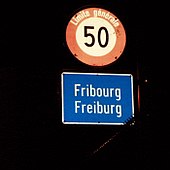
Place-name sign Fribourg Fribourg
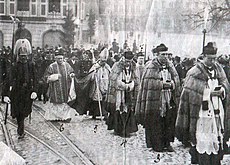
Today rare Catholic life in public space: in the foreground canons in their almutia at the consecration of Bishop André Bovet, 1912.
Search within the encyclopedia